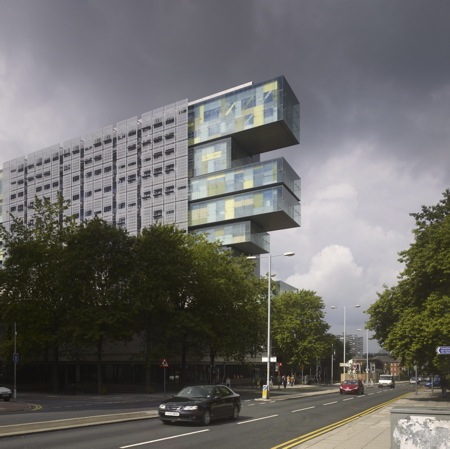Australian architects Denton Corker Marshall have won their country's most prestigious architecture prize - the RAIA Jørn Utzon Award for International Architecture - for their Manchester Civil Justice Centre in England.
The prize was announced at the RAIA awards in Alice Springs on Thursday night.
Here are some new photos of the building by Tim Griffith. The building officially opened earlier this month.
See more photos of the building in our earlier story.
Here's a press release from the architects:
--
Denton Corker Marshall’s 15 level court complex, the practice’s first major public building in the UK, the Manchester Civil Justice Centre, has taken out Australia’s top international architectural award: The RAIA Jørn Utzon Award for International Architecture.
Announced at the RAIA National Awards Presentation in Alice Springs last night, the building beat off competition from a wide range of projects designed by Australian architects in countries such as China, Malaysia, Singapore, New Zealand and other entries from the UK.
Partners John Denton and Barrie Marshall were there on behalf of the practice to accept the award. John Denton commented, “The practice has enjoyed working overseas for a long time particularly in Asia; indeed the Australian Embassy in Beijing won the RAIA’s International Award in 1992.
However, Europe is a much more difficult market for an Australian practice to break into and we were therefore very excited to win the international competition to design the new law courts in Manchester.
We are extremely pleased with its outcome: it has survived the rigours and demands of a public private partnership. We are deeply honoured that it has been recognised in this way by our fellow peers.”
The RAIA jury citation reads:
“This extraordinary new project in Manchester was the result of an international design competition for what is the largest court complex to be built in the United Kingdom for a number of years
“The design of the complex advances a range of ideas about how an institution with hundreds of years of precedent can be made relevant to contemporary society. The bold design replaces the traditional solid courthouse structure, which contains and encloses justice, with an idea about transparency and connection.
“The layered walls, which give the building its distinctive plan form and profile, are essentially varying layers of transparency and solidity, each layer proposing a specific relationship with either the city of Manchester or the court users. The high glazed wall for the public atrium at the building’s forecourt links the building directly to a space of the city. Within the interior of the courts, this transparency continues to mediate the public’s relationship with the court functions. The major courts themselves are arrayed in a dramatic series of cantilever forms at the ends of the building, suggesting quite literally the courts’ dynamic connection to the city.
“The effect of these architectural strategies is to position the courts as open and accessible within a contemporary democratic culture.
“The project also reinforces the value of design competitions for major public buildings, in advancing new ways of thinking about traditional building types.”
The RAIA awards jury was: chair Carey Lyon, Professor Tom Heneghan, Gerard Reinmuth, Professor Brit Andresen, and John Wardle.
For more information on the practice go to www.dentoncorkermarshall.com

